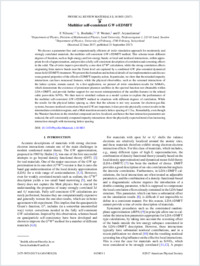Multitier self-consistent $GW+\text{EDMFT}$
- Nilsson, Fredrik Department of Physics, Division of Mathematical Physics, Lund University, Sweden
- Boehnke, Lewin Department of Physics, University of Fribourg, Switzerland
- Werner, Philipp Department of Physics, University of Fribourg, Switzerland
- Aryasetiawan, Ferdi Department of Physics, Division of Mathematical Physics, Lund University, Sweden
-
21.09.2017
Published in:
- Physical Review Materials. - 2017, vol. 1, no. 4, p. 043803
English
We discuss a parameter-free and computationally efficient ab initio simulation approach for moderately and strongly correlated materials, the multitier self-consistent GW+EDMFT method. This scheme treats different degrees of freedom, such as high- energy and low-energy bands, or local and nonlocal interactions, within appropriate levels of approximation, and provides a fully self-consistent description of correlation and screening effects in the solid. The ab initio input is provided by a one-shot G0W0 calculation, while the strong-correlation effects originating from narrow bands near the Fermi level are captured by a combined GW plus extended dynamical mean-field (EDMFT) treatment. We present the formalism and technical details of our implementation and discuss some general properties of the effective EDMFT impurity action. In particular, we show that the retarded impurity interactions can have noncausal features, while the physical observables, such as the screened interactions of the lattice system, remain causal. As a first application, we present ab initio simulation results for SrMoO3, which demonstrate the existence of prominent plasmon satellites in the spectral function not obtainable within LDA+DMFT, and provide further support for our recent reinterpretation of the satellite features in the related cubic perovskite SrVO3. We then turn to stretched sodium as a model system to explore the performance of the multitier self-consistent GW+EDMFT method in situations with different degrees of correlation. While the results for the physical lattice spacing a0 show that the scheme is not very accurate for electron-gas-like systems, because nonlocal corrections beyond GW are important, it does provide physically correct results in the intermediate correlation regime, and a Mott transition around a lattice spacing of 1.5a0. Remarkably, even though the Wannier functions in the stretched compound are less localized, and hence the bare interaction parameters are reduced, the self-consistently computed impurity interactions show the physically expected trend of an increasing interaction strength with increasing lattice spacing.
- Faculty
- Faculté des sciences et de médecine
- Department
- Département de Physique
- Language
-
- English
- Classification
- Physics
- License
-
License undefined
- Identifiers
-
- RERO DOC 306317
- DOI 10.1103/PhysRevMaterials.1.043803
- Persistent URL
- https://folia.unifr.ch/unifr/documents/306290
Statistics
Document views: 100
File downloads:
- pdf: 201
